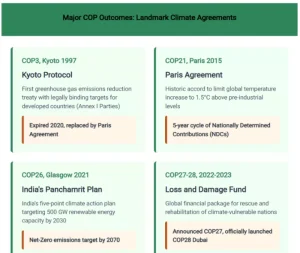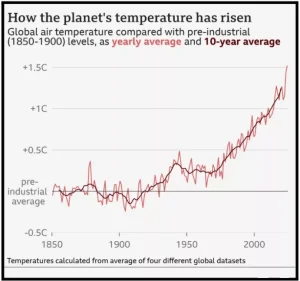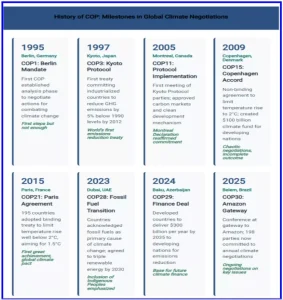![]() 25 Nov 2025
25 Nov 2025

The 30th edition of the Conference of the Parties to the UN Framework Convention on Climate Change (COP30), the annual two-week climate talks, concluded in Belem, Brazil on 22nd November.
PWOnlyIAS Extra Edge:
About COP
Why was the 30th Conference of the Parties (COP30) held in Brazil?
|
|---|
| Outcome / Initiative | Key Details |
| Belém Health Action Plan |
|
| Tropical Forests Forever Facility (TFFF) |
|
| Belém Political Package |
|
| Santa Marta Conference (2026) |
|
| Open Planetary Intelligence Network (OPIN) |
|
| Global Ethical Stocktake (GES) |
|
| Belém 4× Sustainable Fuels Pledge |
|
| Belém Declaration on Hunger, Poverty & People-Centred Climate Action |
|
| NAP Implementation Alliance |
|
| Global Implementation Accelerator |
|
| Belém Mission to 1.5 |
|
| Global Mutirão Decision |
|
| Global Mutirão Platform |
|
| Just Transition Mechanism |
|
| Forest & Climate Roadmap |
|
| Transitioning Away From Fossil Fuels Roadmap |
|
| Fostering Investible National Implementation (FINI) |
|
| Gender Action Plan |
|
| Initiative | Key Details / Highlights |
| Climate Finance & Equity |
|
| Forests & Nature-Based Solutions |
|
| Health and Resilience |
|
| Sustainable Fuels & Bioenergy |
|
| Adaptation & NAPs |
|
 Re-centring Climate Justice: The summit renewed focus on equity, CBDR-RC (Common but Differentiated Responsibilities and Respective Capabilities), and prioritised the rights and needs of climate-vulnerable populations.
Re-centring Climate Justice: The summit renewed focus on equity, CBDR-RC (Common but Differentiated Responsibilities and Respective Capabilities), and prioritised the rights and needs of climate-vulnerable populations.
The Role of the COP in Addressing Climate Change
Current Global Priorities After COP30
|
Check Out UPSC CSE Books
Visit PW Store

 Protect Developing Countries from Green Protectionism: Develop WTO-consistent frameworks to prevent CBAM-like measures from unfairly impacting developing economies.
Protect Developing Countries from Green Protectionism: Develop WTO-consistent frameworks to prevent CBAM-like measures from unfairly impacting developing economies.The COP30 signalled a transition toward implementation, justice, and community-centred climate action. Despite unresolved divides over finance, fossil fuels, and trade, the summit strengthened global momentum on equitable finance, forest protection, health resilience, and poverty-centred adaptation, keeping vulnerable populations at the core of climate governance.

<div class="new-fform">
</div>